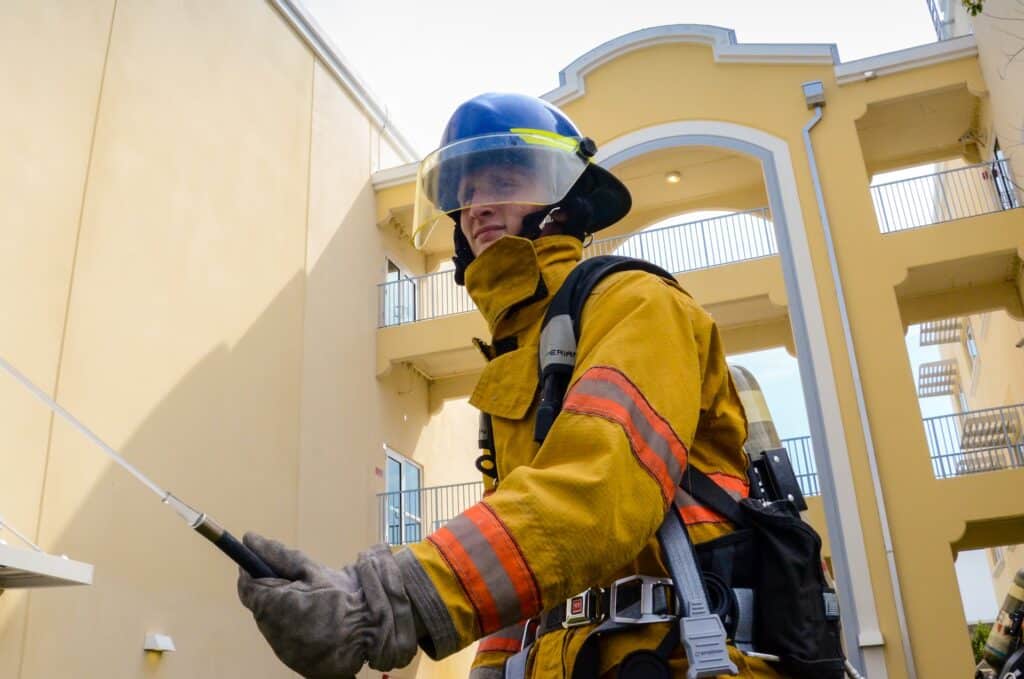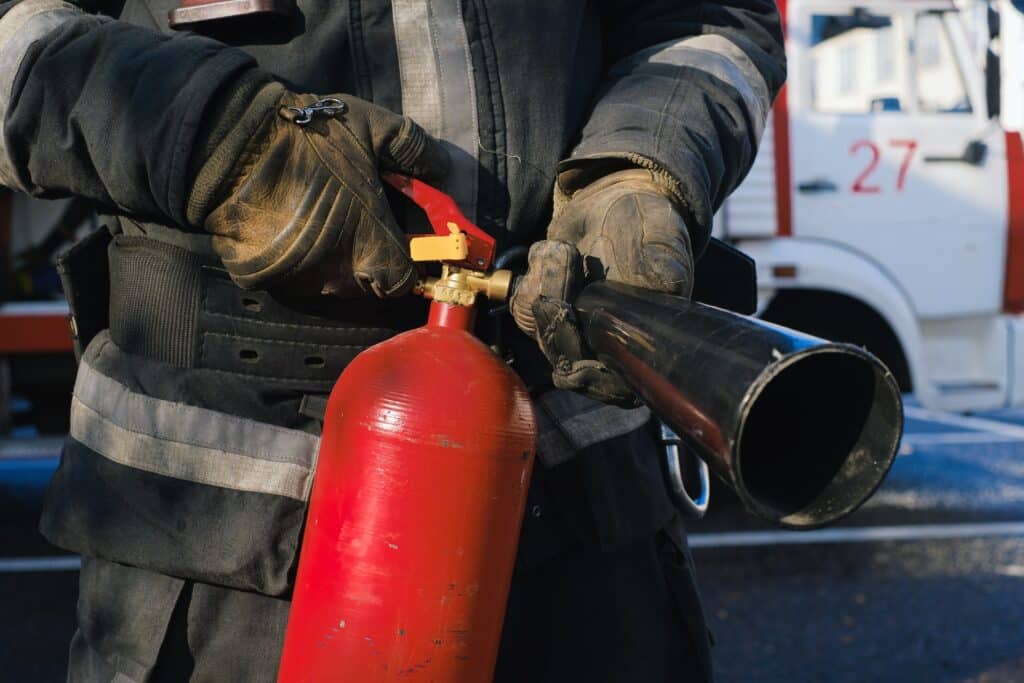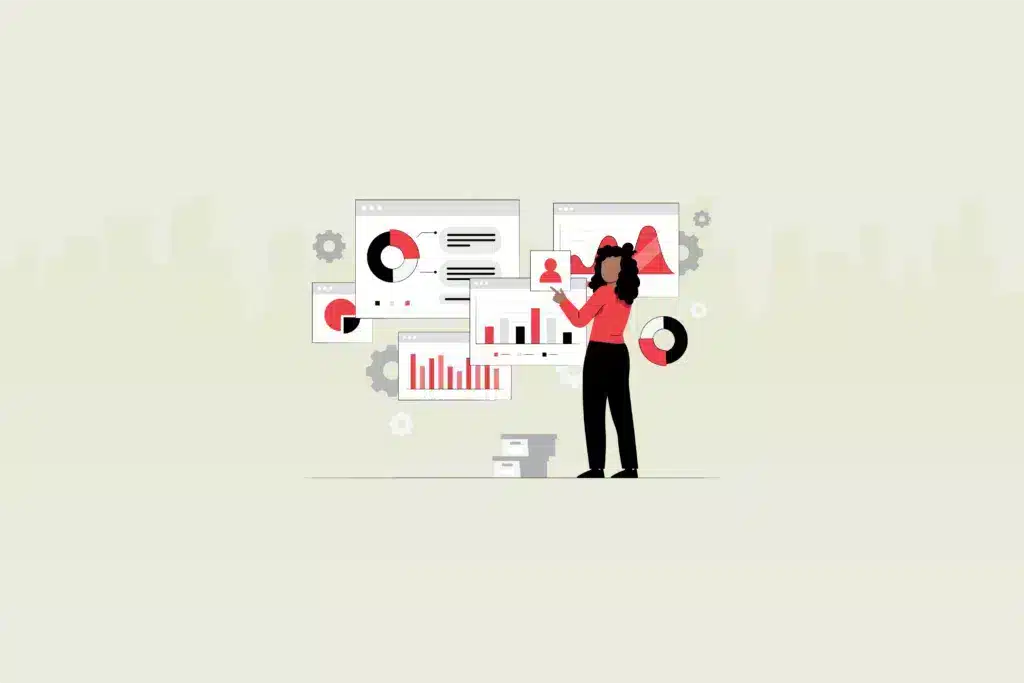Firefighters are the first responders who put their lives on the line to protect people, property, and the environment from the ravages of fire and other disasters. As a cornerstone of any community, firefighters not only ensure safety but also contribute significantly to the overall growth and stability of a company or region. The task of hiring a firefighter goes beyond the conventional recruitment process, as it requires a careful evaluation of a unique set of skills.
In this blog, we delve into the intricate process of selecting the right firefighters for your team. From identifying essential hard and soft skills to crafting job descriptions and conducting interviews, we will guide you through the steps to ensure you find the perfect fit.
Additionally, we’ll explore effective methods to assess on-the-job capabilities, preventing costly mis-hires that could hinder your firefighting unit’s efficiency. Join us as we navigate the path to recruiting skilled and dedicated firefighters who are not only prepared to combat emergencies but also bolster your organization’s growth.
What is the role of a firefighter?
At the heart of public safety, a firefighter is a professional trained to combat a range of emergencies beyond just fires. These brave individuals play a crucial role in safeguarding lives, property, and the environment from various hazards. Firefighters don’t just battle blazes; they respond to medical emergencies, hazardous material incidents, and natural disasters, serving as a frontline defense against chaos.
Roles and responsibilities:
Fire Suppression: Extinguishing fires using specialized equipment and techniques to minimize damage.
Emergency Medical Response: Providing immediate medical care and life-saving interventions.
Search and Rescue: Rescuing individuals from hazardous situations such as collapsed buildings or vehicle accidents.
Hazard Mitigation: Handling hazardous materials and preventing environmental contamination.
Public Education: Conducting community outreach and education to promote fire safety awareness.
Preventive Measures: Inspecting buildings for fire code compliance and implementing safety protocols.
Collaboration: Coordinating with other emergency services to ensure effective disaster response.
Contribution to Company’s Growth: A proficient firefighter doesn’t just protect lives and property; they contribute to a company’s growth by ensuring operational continuity, minimizing downtime, and fostering a safer work environment. Their prompt response to emergencies helps maintain business operations, reduces financial losses, and enhances the company’s reputation for employee safety and well-being. Through community engagement and education, firefighters also build strong relationships with local residents, fostering goodwill that can positively impact a company’s image.
Hard skills to assess in a firefighter
When evaluating candidates for the critical role of a firefighter, certain hard skills are paramount in ensuring effective emergency response and safeguarding lives. These technical proficiencies can be the difference between effective disaster management and potential chaos. Here’s what to look for when assessing firefighter hard skills:
1. Fire Suppression Techniques: Candidates should be well-versed in various methods of extinguishing fires, including handling fire hoses, using fire extinguishers, and employing advanced techniques like ventilation and salvage operations.
2. Emergency Medical Training: Proficiency in basic medical care, CPR, and first aid is crucial, as firefighters often act as first responders to medical emergencies before paramedics arrive.
3. Search and Rescue Operations: An understanding of techniques for locating and extracting individuals from hazardous environments is vital, ensuring a quick and safe response to emergencies.
4. Hazardous Materials Handling: Firefighters must be trained to manage hazardous substances safely, preventing further harm and environmental damage during incidents involving dangerous chemicals.
5. Equipment Operation: Competence in operating complex firefighting equipment, such as ladders, hydraulic tools, and breathing apparatus, is essential for effective emergency management.
6. Incident Command System (ICS): Familiarity with ICS protocols ensures seamless communication and coordination during large-scale emergencies, enhancing overall response efficiency.
Assessment methods:
- Practical Drills: Simulate real-life scenarios to assess candidates’ ability to execute firefighting techniques under pressure.
- Written Examinations: Evaluate theoretical knowledge of fire suppression tactics, equipment usage, and safety protocols.
- Scenario-Based Interviews: Pose hypothetical emergency situations to gauge candidates’ decision-making and problem-solving skills.
- Certification Verification: Validate candidates’ existing certifications and training records to ensure they meet industry standards.
By scrutinizing these firefighter hard skills through rigorous evaluation methods, you can confidently select candidates who are equipped to tackle the challenges of emergency response and contribute effectively to your firefighting team’s success.
Soft skills to assess in a firefighter
Beyond technical expertise, successful firefighters possess a range of soft skills that are instrumental in navigating high-stress situations, fostering effective teamwork, and maintaining a strong public image. As you assess candidates for the firefighter position, consider these crucial interpersonal qualities:
1. Communication Proficiency: Clear and concise communication is paramount in conveying instructions, updates, and reassurance during emergencies. Look for candidates who can articulate information effectively under pressure.
2. Adaptability and Resilience: Emergency situations are unpredictable, demanding firefighters to remain composed in dynamic environments. Seek candidates who demonstrate adaptability, resilience, and the ability to think on their feet.
3. Team Collaboration: Firefighting is a collective effort, requiring seamless teamwork. Assess candidates’ ability to collaborate, support their colleagues, and maintain a cohesive unit even amidst challenging circumstances.
4. Problem-Solving Aptitude: Quick thinking and resourcefulness are essential. Look for individuals who can analyze complex situations and devise innovative solutions under time constraints.
5. Empathy and Compassion: Firefighters often interact with individuals in distress. A compassionate and empathetic approach is crucial for reassuring victims and offering support during traumatic events.
6. Leadership Potential: While firefighters work as a team, leadership skills are still valuable, especially during critical moments. Identify candidates who can take charge when needed and guide others effectively.
Assessment methods:
- Group Activities: Observe candidates in collaborative scenarios to evaluate teamwork, communication, and leadership dynamics.
- Role-Play Scenarios: Present candidates with simulated emergencies to assess their ability to communicate, make decisions, and provide reassurance.
- Behavioral Interviews: Ask about past experiences where candidates demonstrated adaptability, empathy, or problem-solving skills.
- Reference Checks: Reach out to previous supervisors or colleagues to gain insights into candidates’ interpersonal skills and work demeanor.
By carefully evaluating these firefighter soft skills, you can assemble a team that not only possesses technical expertise but also demonstrates the interpersonal qualities necessary to excel in the demanding and impactful role of a firefighter.

How to test a firefighter’s skills
Evaluating a firefighter’s technical skills is a critical step in ensuring their readiness for the complex challenges they’ll face in emergencies. Rigorous testing methods are essential to gauge their competency and suitability for the role. Here are several valuable technical tests to consider:
1. Fire Suppression Drills: Conduct live fire simulations where candidates demonstrate their ability to handle firefighting equipment, coordinate hose teams, and implement proper suppression techniques. This practical assessment mirrors real-life scenarios and provides insight into their readiness under pressure.
2. First Aid and Medical Scenarios: Present candidates with medical emergencies, requiring them to administer basic medical care, CPR, and first aid. This evaluation showcases their capacity to provide immediate assistance until specialized medical teams arrive.
3. Equipment Proficiency Tests: Administer assessments focused on candidates’ familiarity with and operation of firefighting equipment, from ladders to hydraulic tools. Proficiency in using these tools is integral to efficient emergency response.
4. Hazardous Materials Handling: Simulate scenarios involving hazardous substances and assess candidates’ knowledge of proper containment, protection, and decontamination procedures. Their grasp of hazardous material protocols is crucial to minimize risk.
5. Incident Command Simulations: Present candidates with complex incidents, challenging them to apply Incident Command System (ICS) principles. This evaluates their decision-making, communication, and leadership skills in a dynamic setting.
Importance of testing:
- Accuracy in Selection: Rigorous testing ensures that selected candidates possess the technical skills needed to handle emergencies effectively, minimizing risks to themselves and others.
- Enhanced Safety: Proficiency in technical aspects like fire suppression and equipment operation directly impacts the safety of the firefighting team and the public they serve.
- Operational Efficiency: Well-tested skills lead to efficient emergency response, enabling faster containment and mitigation of incidents, which can limit damage and save lives.
- Trust and Confidence: Thorough testing instills confidence in the firefighting team’s abilities, fostering trust within the organization and the community they serve.
By employing these comprehensive technical tests, you can confidently assess a firefighter’s aptitude to execute their duties competently, ensuring that your team is equipped to handle diverse emergencies with precision and professionalism.
Where to find the best firefighters
Identifying the most qualified firefighters for your team requires strategic sourcing from various talent pools. Here’s how to effectively discover the right candidates and utilize platforms to your advantage:
1. Firefighter Training Academies: Begin your search at local fire training academies and institutions. These establishments nurture individuals passionate about firefighting, providing you access to fresh talent with foundational skills.
2. Job Boards and Websites: Utilize dedicated job boards and websites catering to emergency services and public safety. Platforms like FirefighterJobs, GovernmentJobs, and LinkedIn’s public safety groups can connect you with experienced professionals.
3. Networking Events: Attend industry conferences, workshops, and seminars focused on firefighting and emergency response. Networking with attendees can introduce you to potential candidates who are actively engaged in their field.
4. Volunteer Fire Departments: Explore candidates from volunteer firefighting organizations. These individuals often have practical experience and a strong commitment to the profession, making them valuable additions to your team.
5. Military Veterans: Consider recruiting candidates with military backgrounds, as their discipline, teamwork, and adaptability are assets that translate well to firefighting.
6. Social Media: Leverage social media platforms like LinkedIn, Facebook groups, and Twitter to showcase your firefighting team’s culture and opportunities. Engaging content can attract candidates interested in making a meaningful impact.
7. Referrals and Current Employees: Encourage your current team members to refer potential candidates. Those already in the field often have valuable connections and insights into who might be a good fit.
8. Community Engagement: Engage with the local community through events, workshops, and outreach programs. Building connections with residents can lead to discovering candidates who are committed to serving their community.
By diversifying your approach and tapping into these talent sources, you can cast a wide net to identify the best-suited firefighters. Tailor your recruitment strategies to each platform’s strengths, whether it’s targeting experienced professionals or nurturing fresh talent, to ensure a steady influx of qualified individuals ready to join your firefighting team.
Firefighter job description template
Firefighter job description
About Us: [Company Name] is a dynamic and community-focused emergency response team dedicated to safeguarding lives, property, and the environment. As a vital part of our community, we are committed to providing rapid and effective emergency services, ensuring the safety and well-being of all residents.
Responsibilities:
- Respond promptly to emergency situations, including fires, medical incidents, hazardous materials incidents, and natural disasters.
- Operate firefighting equipment, including hoses, ladders, and hydraulic tools, to suppress fires and protect life and property.
- Perform search and rescue operations, extricating individuals from hazardous environments and providing immediate medical assistance.
- Implement and follow established incident command protocols to ensure seamless coordination during emergencies.
- Conduct inspections of buildings and facilities to ensure compliance with fire codes and safety standards.
- Engage in community outreach and education programs to enhance fire safety awareness and foster positive relationships within the community.
Qualifications:
- High school diploma or equivalent (Bachelor’s degree in Fire Science or related field preferred).
- Certified Firefighter I and II or equivalent certifications.
- Emergency Medical Technician (EMT) certification or higher.
- Proficient knowledge of firefighting techniques, equipment operation, and hazardous materials handling.
- Strong communication, problem-solving, and teamwork skills.
- Physical fitness and ability to perform physically demanding tasks in challenging environments.
- Valid driver’s license and clean driving record.
Why join us?
- Make a meaningful impact by serving your community and protecting lives.
- Work alongside a dedicated and supportive team of professionals who share your passion for public safety.
- Access to ongoing training and professional development opportunities.
- Competitive compensation and benefits package.
- Opportunity for career growth within a respected emergency response organization.
Benefits:
- Competitive salary and incentives.
- Comprehensive health, dental, and vision insurance.
- Retirement savings plan.
- Paid time off and flexible scheduling.
- Professional development and training opportunities.
- Supportive and inclusive work environment.
Application Process: Interested candidates are invited to submit their resume and cover letter detailing their relevant experience and qualifications to [Email Address]. Applications will be accepted until [Closing Date]. Shortlisted candidates will be contacted for interviews.
Note: [Additional important information about the application process, requirements, or any other relevant details can be added here.]
You can customize this job description template to match your organization’s specific needs and culture.

How much does a firefighter cost?
The cost of hiring firefighters in the US varies based on experience and skill levels. On average, entry-level firefighters earn approximately $40,000 to $50,000 annually. As experience grows, firefighters with 5 to 10 years of service see their salaries rise to around $55,000 to $70,000. Those with over a decade of experience, including leadership roles, can earn upwards of $80,000 annually. These figures encompass base salaries and may increase with overtime, additional certifications, and specialized skills such as hazardous materials or technical rescue expertise.
Firefighter interview questions
Conducting a comprehensive interview is crucial in selecting the right firefighter for your team. To assess a candidate’s suitability, we’ve categorized these questions into three key areas: soft skills, hard skills, and general skills.
Why Asking These Questions Matters: Effective firefighting demands a unique blend of technical expertise, interpersonal finesse, and adaptability. These questions delve into candidates’ abilities, ensuring they possess the essential skills to excel in the demanding and vital role of a firefighter.
Soft skills:
1. Can you describe a time when you demonstrated effective communication during a high-stress situation?
2. How do you handle challenging situations that require quick decision-making and adaptability?
3. Tell us about an experience where you had to work collaboratively in a team to achieve a common goal.
Hard skills:
4. Walk us through your experience with fire suppression techniques and the types of equipment you’re proficient in using.
5. Can you provide an example of a successful search and rescue operation you were a part of?
6. Describe your knowledge of hazardous materials handling and protocols for minimizing risk.
General skills:
7. How do you stay up-to-date with the latest advancements and best practices in firefighting?
8. Have you ever had to take a leadership role during an emergency? How did you manage the situation?
9. Tell us about a time when you had to make a split-second decision that had a significant impact.
Interpersonal skills:
10. How do you approach interacting with distressed individuals or victims during emergencies?
11. Can you provide an example of a time you showed empathy and compassion while on duty?
Problem-solving skills:
12. Describe a challenging incident you encountered and how you devised a creative solution to manage it.
Leadership skills:
13. Have you ever been in charge of coordinating a team during an emergency? How did you ensure effective communication and execution?
Adaptability and resilience:
14. Tell us about a situation that didn’t go as planned during an emergency. How did you adapt and recover?
Community engagement:
15. How have you contributed to community outreach and fire safety education?
These questions offer insights into candidates’ experiences, thought processes, and suitability for the firefighter role. Tailoring your interview approach to these skill categories helps ensure you select candidates who possess the essential attributes required to excel in this critical profession.
Assessing firefighter skills to avoid mis-hires
The recruitment process for firefighters is a high-stakes endeavor that demands meticulous evaluation to prevent mis-hires. Incorporating tailored firefighter assessment not only expedites the hiring process but also enhances the accuracy of candidate evaluations.
Reducing Time to Hire: Assessments offer a structured approach to gauging candidates’ technical and soft skills, streamlining the initial screening phase. This leads to quicker identification of top talents, allowing you to focus your efforts on candidates who align closely with the role’s demands.
Enhancing Evaluation Precision: Assessments provide an objective and standardized way to measure candidates’ firefighting aptitude. By simulating real-world scenarios, they uncover candidates’ abilities in controlled environments, offering insights into how they might perform during emergencies.
To optimize your firefighter hiring process, consider Testlify. With customizable assessments designed to evaluate both hard and soft skills, Testlify helps you make informed decisions. Schedule a free 30-minute live demo today to discover how Testlify can revolutionize your recruitment efforts and ensure you select candidates primed to excel in the challenging and vital role of a firefighter.








